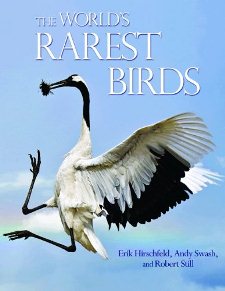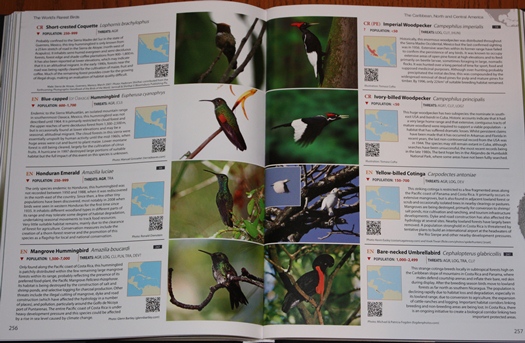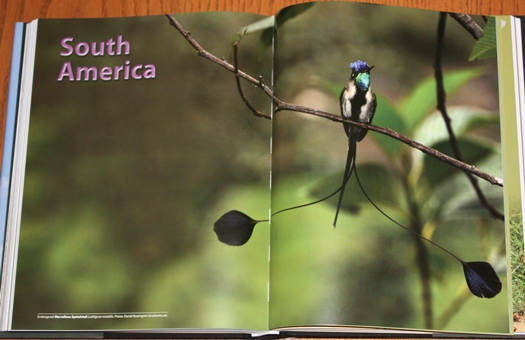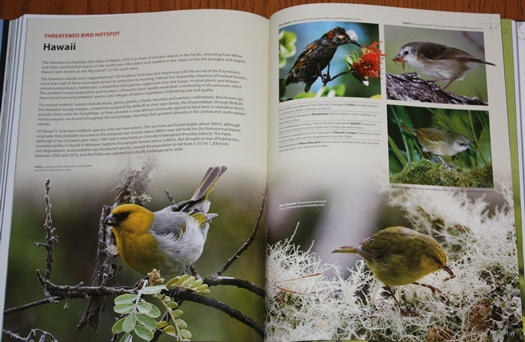Reviewed by Grant McCreary on May 20th, 2013.
Birders have a thing for rare birds. These are the birds that we fantasize about (who hasn’t daydreamed a little about finding a possibly extinct bird?) or make pilgrimages to go see. And, if the number of titles on the subject that have been published in the last few years is any indication, birders also have a thing for books about rare birds. I know I do, anyway. Now we have another to consider.
The World’s Rarest Birds covers the 590 birds that are classified as Endangered or Critically Endangered by BirdLife International, or now exist only in captivity. The authors’ intent is to review their current status, reasons why they’re threatened, distribution, and ecology. Each species account is a quarter of a page, but they are thoughtfully designed to pack in a lot of information, including population size and trend. In addition to the text, each account has a single illustration, range map, and QR code. Yes, those little square things that you scan with your mobile phone. In this case, they lead you to the BirdLife webpage for the species where you can find even more detailed information.
The range maps are somewhat disappointing; they’re small, not very precise, and don’t show any political boundaries. You’ll likely have to read the text to determine in which countries the birds are found. But I suppose they’re adequate for a work like this.
The photographs, on the other hand, are amazing. One of the difficulties in producing a book on rare birds is that photographs for many of them are difficult to obtain. So the authors tried an unconventional approach – they ran a contest. Birders and photographers worldwide contributed photos in the hopes of getting them published in this book (along with prizes, of course!). The result is that most species are illustrated by a very nice photo.
But even with the contest, photos for 75 birds couldn’t be found, so artist Tomasz Cofta provided the illustrations for these. I’m very glad that these birds are shown, but I must say that I’m not a big fan of Cofta’s work here. Some look very nice, but most seem stiff and un-lifelike to me. Actually, the main problem is that a somewhat natural fore and background have been added, but are extremely blurred so as to appear out of focus, like in a photograph. When it works it looks fantastic (see Timor Green-pigeon), but mostly rather than making the illustration more realistic it calls attention to its artificiality.
The birds are organized by region: Europe and the Middle East; Africa and Madagascar; Asia; Australasia; Oceanic Islands; the Caribbean, North and Central America; and South America. Each region opens with a striking two-page photo (or Cofta illustration as in the case of the Ivory-billed Woodpecker for North/Central America). Following that are maps showing the distribution of the threatened birds in the region and a short introduction. Finally, each region, with the exception of Europe, features three to six profiles of a threatened bird hotspot or conservation challenge. These focus on such places as Hawaii and groups of birds like albatrosses and vultures. There is even more introductory material at the beginning of the book, including a look at all the types of threats facing birds. Overall, these sections are my favorite sections of the book as they highlight critical issues, many of which you may not be familiar with.
Abbreviated accounts for an additional 60 “data deficient” species close out the book. Only a third of them are shown in a photograph and, as you would imagine with this category, the accounts are filled with question marks and the word “unknown”. But I find this section fascinating; it’s amazing how many of these birds are known from just a couple of specimens. Perhaps the most telling portion of this chapter is a map showing the global distribution of all data deficient birds. As you would expect, there’s a band of color running along the equator, where overall bird diversity is the highest. But a closer look reveals some intriguing things. One is that New Guinea hosts more of these species than anywhere else. There’s also an interesting cluster of dots in central Asia. But I wonder if the main thing shown by this map is a visual representation of the regions where our overall knowledge of birds is the most lacking.
Back to the photographs for a minute – this book is filled with them! One or (usually) more grace nearly every page. And not only are the photos themselves very nice, I love how they’re incorporated onto the page. The design of this book is simply outstanding. The only issue I have with it is that the photos aren’t labeled with the place or date they were taken. That should be required in any such book like this.
Recommendation
Extraordinary images and design, along with authoritative text, make The World’s Rarest Birds the best book on rare birds of the world that I’ve seen. I’m very glad to have it, but at the same time saddened that it has to exist at all. But since there are birds in trouble we need a book like this to tell their stories. It belongs on the table – not the shelf – of anyone who cares about birds.
Disclosure: I get a small commission for purchases made through links in this post.
Disclosure: The item reviewed here was a complementary review copy provided by the publisher. But the opinion expressed here is my own, it has not been influenced in any way.








Comment